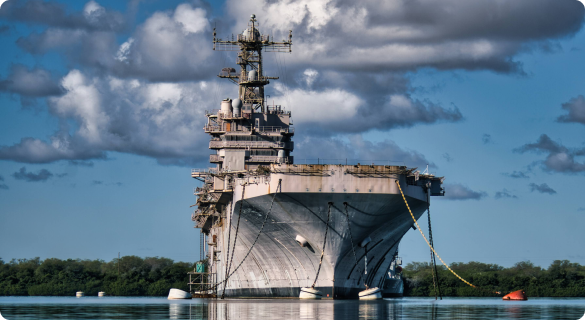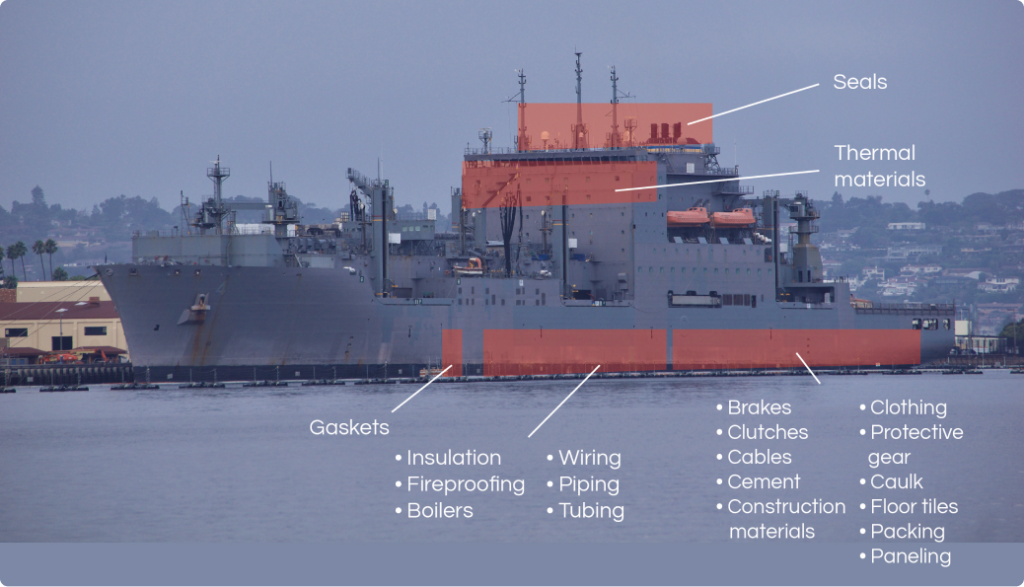Asbestos Onboard U.S. Navy Ships
At The Gori Law Firm, our experienced Navy mesothelioma lawyers understand the unique challenges veterans face when seeking compensation for asbestos-related illnesses that they have been diagnosed with as a result of their service, and we’re ready to help you and your family get the compensation and justice you deserve.

Home » Nationwide Mesothelioma Lawyers » Veterans and Mesothelioma » Navy » Asbestos on Navy Ships
- Content last modified:
Navigate this page
- List of U.S. Navy Ships with Asbestos
- Millions Recovered for Those Exposed to Asbestos Aboard Navy Ships
- Asbestos Exposure on Navy Ships
- Where Was Asbestos Found on Navy Ships?
- What Jobs Onboard Ships Are at the Most Risk for Exposure?
- Mesothelioma Risks for Navy Veterans
- Helping Sailors Exposed to Asbestos for Over 20 Years
- Navy Ship Asbestos FAQs
U.S. Navy veterans have one of the highest rates of asbestos exposure among all military branches because the toxic material was used on almost every Navy vessel during most of the 20th century. Many of these veterans later developed an asbestos-related disease like mesothelioma, an aggressive and deadly form of cancer, and are now eligible for compensation for the harm they have suffered.
List of U.S. Navy Ships with Asbestos
The military used asbestos in a wide variety of applications. Many military veterans were exposed to asbestos on Navy vessels, and Navy and Coast Guard personnel were frequently exposed to asbestos-laden products.
The following vessels are known to have contained asbestos or asbestos-laden products. Navy and Coast Guard vessels are listed below in alphabetical order:
Millions Recovered for Those Exposed to Asbestos Aboard Navy Ships
Our firm has recovered more than $4 billion in compensation for people who developed mesothelioma and other conditions from asbestos exposure. We work closely with clients to provide them with the personal support and resources they need throughout their cases. Some notable settlements and verdicts we’ve obtained for Navy veterans who experienced asbestos exposure during their service are listed below:
Mesothelioma
Navy service member
Mesothelioma
Navy service member
Mesothelioma
Navy service member
Mesothelioma
Navy service member
Mesothelioma
Navy boiler tender
Mesothelioma
Navy service member
Mesothelioma
Navy radar technician
Mesothelioma
Navy service member
Asbestos Exposure on Navy Ships
Asbestos was commonly used in naval vessels in the 20th century for its fire-retardant and insulative properties. Because of that extensive usage, Navy veterans had a high risk of asbestos exposure and now face a higher likelihood of developing asbestos-related cancers like mesothelioma 10 to 50 years after exposure.
The U.S. government mandated the use of asbestos in Navy ships until the 1970s, when the health risks associated with the material became more widely known. The production of ships and service on ships ramped up during World War II and continued through the Cold War, meaning even more Navy personnel were exposed to asbestos.
A recent study of veterans who served during the atomic-testing era highlights the heightened risk of asbestos exposure for Navy service members. Between 1945 and 1962, the U.S. conducted 230 above-ground atmospheric nuclear weapons tests involving more than 250,000 military personnel. Researchers conducted the first quantitative assessment of asbestos-related mesothelioma among military personnel who participated in the nuclear testing. The assessment studied 114,000 atomic veterans, and the 70,000 Navy personnel in the study had higher mortality rates from mesothelioma than members of any other branch. Since the only known cause of mesothelioma is asbestos exposure, these heightened mortality rates are attributed to the higher incidence of asbestos exposure.

Where Was Asbestos Found on Navy Ships?
On Navy ships, asbestos was found in numerous places and materials. Asbestos products used on these vessels include the following:
- Insulation
- Fireproofing
- Boilers
- Gaskets
- Seals
- Brakes
- Clutches
- Cables
- Wiring
- Cement
- Construction materials
- Clothing
- Protective gear
- Caulk
- Floor tiles
- Packing
- Paneling
- Piping
- Tubing
- Thermal materials
- And more

What Jobs Onboard Ships Are at the Most Risk for Exposure?
Due to the widespread use of asbestos on Navy ships, one-third of all mesothelioma patients today are Navy veterans or former shipyard workers. In particular, the following naval occupations have been found to have the highest risk for asbestos exposure:
- Machinist’s mates
- Pipefitters
- Boiler technicians
- Fire control technicians
- Water tenders
Mesothelioma Risks for Navy Veterans
Because of the commonality of asbestos use in U.S. Navy vessels from the 1930s to 1980s, Navy veterans have one of the highest rates of asbestos-related diseases among all military branches. Mesothelioma, an aggressive cancer affecting the tissue lining the lungs and other organs, is one of the most deadly asbestos-related diseases. Asbestos exposure is the only known cause of mesothelioma, and it is highly resistant to many common cancer treatments. The average survival period following a mesothelioma diagnosis is 12 to 21 months.
When materials containing asbestos begin to deteriorate, asbestos fibers become airborne and inhaled or ingested. The fibers can then become lodged in bodily tissue, causing inflammation that can lead to serious health conditions, including mesothelioma, lung cancer, and asbestosis.
Mesothelioma has a long latency period, meaning it can take decades to develop. Therefore, many Navy veterans exposed to asbestos 10 to 60 years ago may still develop the disease.
If you or a loved one have been diagnosed with mesothelioma or another condition from asbestos exposure, you have a right to compensation.
Helping Sailors Exposed to Asbestos for Over 20 Years
If you were in the Navy and have been diagnosed with mesothelioma, you may be entitled to significant compensation. Our Navy mesothelioma lawyers have a proven track record of fighting against asbestos product manufacturers for over 20 years, securing over $4 billion in compensation for veterans and their families.
We are devoted to advocating for Navy veterans who unknowingly came into contact with asbestos during their military service. We understand the toll a serious health condition can take on a person and their family, and we are ready to provide legal expertise and empathetic support during this difficult time.
To learn more about your mesothelioma compensation options, contact us today for a free consultation and case evaluation by calling 866-989-3926 or filling out our online contact form. With 10 offices in seven states, we serve clients throughout the United States, and we’ll make a donation to the Mesothelioma Applied Research Foundation if you allow us to review your case.

Navy Ship Asbestos FAQs
Is Asbestos Still Used on Navy Ships?
Although asbestos use in modern ships has decreased, older vessels still contain the material, as it was used in nearly all Navy ships built between the 1930s and early 1980s. The Navy restricted the use of asbestos in building new ships in the late 1970s after the health risks associated with asbestos became widely known. It also began renovating many existing ships to remove asbestos-containing products. However, asbestos was still used in some applications well into the 1980s, and many older ships may still contain the material.
When Was Asbestos Removed From Navy Ships?
Most vessels built before the 1980s used asbestos in some capacity, as the Navy used asbestos-containing products due to their water resistance, fire resistance, and low cost. Recent efforts have been made to remove and replace asbestos-containing products and materials on naval vessels. However, some older vessels may still contain asbestos.
Will I Be Suing the Military or Government for Asbestos Exposure Onboard Navy Ships?
Veterans and service members cannot sue the military or the government. However, those exposed to asbestos during their Navy service may still pursue civil lawsuits against other parties responsible for their asbestos-related health conditions. In these cases, liability for asbestos exposure lies with the parties that manufactured or supplied the asbestos-containing products to the Navy, not with the U.S. government.
Navy veterans who have been diagnosed with an asbestos-related health condition can also file a claim with the U.S. Department of Veterans Affairs for disability benefits, including free health care and monthly compensation. To succeed in a mesothelioma VA claim, you must show your condition is connected to your military service.


